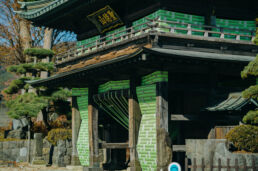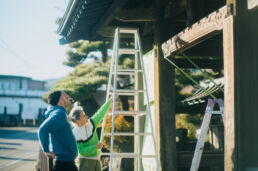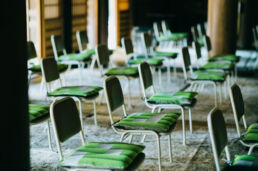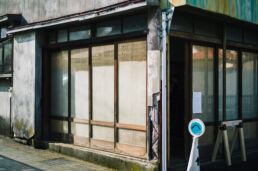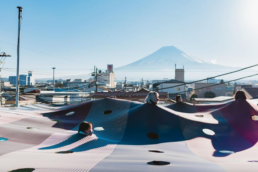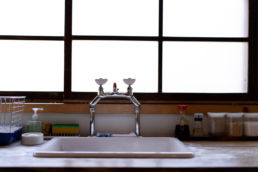In the winter of 2022, I visited “FUJI TEXTILE WEEK 2022” held in the city of Fujiyoshida, a textile production center in Yamanashi Prefecture. This is the second time the festival has been held, previously in 2021. From the foot of Mt. Fuji towering above, the crisp winter air, we report on FUJI TEXTILE WEEK 2022, which has evolved since the last time it was held.
Artists' Impossible Tasks x Textile Company's Struggle
FUJI TEXTILE WEEK 2022 consisted of the art exhibition “Weaving and Signs,” in which artists exhibited their works using textiles as the primary material, and the production area exhibition “WARP & WEFT,” which introduced the past and present history of production areas along with the transition of their products. The exhibition was held at galleries, temples, parks, and vacant houses scattered throughout the Shimoyoshida area, and guided by local volunteers who guided visitors back and forth along a one-kilometer route, allowing them to enjoy the local scenery as well.
After checking in at the information desk located in a corner of the shopping district, my first stop was an old three-story storehouse occupied by Yoko Ando. As I walked up the darkened room with only a small window, I saw work made of bundles of white threads hanging down like a curtain, swaying faintly in the breeze. The threads were cupra, a light, thin fiber often used for suit linings, and characterized by its glossy luster. The bundles of threads caught the light coming in through the window, giving off a divine appearance like a path leading to the sky.
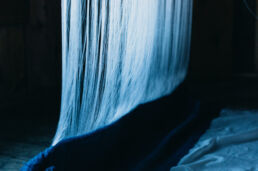
Watanabe Textile, one of the local weavers, created this work using advanced weaving techniques, however in responding to the exhibition, he was able to discover a new technique. It was a meaningful experience for Mr. Tatsuyasu, who is also involved in product creation as an artist and a textile specialist.
Many of the works in this art exhibition were created through collaboration between artists and the machine shops. Usually, manufacturing as an industry is overwhelmingly considered from the perspective of whether it will sell or not, or whether it is profitable. However, it is difficult to break out of existing ideas by doing just that. By collaborating with artists, in other words, by “confronting the artists’ impossible challenges,” new discoveries are made from a free perspective, which may develop into the next product. This is the secret wish of the organizer in holding art events, and the synergistic effect that can be expected only from art events based on industries rooted in the community.
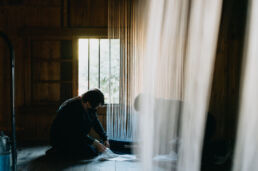
Art may eventually become commonplace in the city
The work of Dutch artist Sigrid Kallon, exhibited at Fukugenji Temple, was also interesting. The entire temple gate and the front facade of the main building were dynamically covered with cloth and discarded hemp (scraps of cloth left over from weaving), and the cushions laid out in the main building were also changed to bright fluorescent fabric, but a closer look reveals that the surface is a gaudy yellowish green, while the reverse side is a calm gray fabric.
This response is because the textiles of Fuji-Yoshida were originally developed around temple interiors and cushions. Since Buddhist memorial services are held during the Textile Week, an eccentric design might surprise parishioners. The idea was to turn it inside out so that the Buddhist memorial service could be held without hindrance.
Thanks to this consideration, the zabuton will continue to be used at Fukugenji even after the session is over. Come to think of it, the traditional cloth with lots of gold threads that we are used to seeing at temples must have once had a flashy and eccentric design. The fluorescent-colored fabric may one day become a familiar sight.
Participation of foreign artists
The most significant difference between this year’s event and the previous one was the participation of overseas artists, including Sigrid Calon. Last time, due to the Corona Disaster, it was not possible for artists from overseas to come to Japan, and all participating artists were from Japan, but this time artists based in the U.S. and the Netherlands were able to participate. This allowed the textiles and the town of Fujiyoshida to be interpreted from a more multifaceted perspective, broadening the scope of the event and creating connections with the rest of the world, including visits by officials and media from the countries where the artists were based.
The Embassy of the Netherlands also subsidized the entire art event with the participation of Sigrid Calon. The city of Tilburg in the Netherlands, where she usually works, has been lined with textile workshops for centuries, and there is an overlap with the city of Fujiyoshida. We look forward to continued collaboration between these two cities, which have something in common, transcending time and country.
Hélène Lauth, who lives in France and focuses her work on familiar city scenes, was inspired to participate in this exhibition by her participation in the Saruya Artist Residency. During her long stay in Fujiyoshida, she interacted with local children, some of whom were inspired to start painting. Many artists have participated in the Saruya Artist Residency in the past, and the relationship with France is expected to deepen with the participation of Hélène Lauth, who has also won awards in France, in FUJI TEXTILE WEEK 2022.
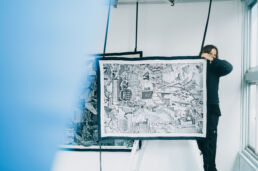
In the wake of Corona, the world experienced a regressive experience of “division”. Once separated from each other, we now realize the importance and fragility of having a connection. I am excited to see what fun things will come out of the relationships that have been reconnected through textiles and art.
Continue to the Part. 2
Written by:
Yumi Igarashi
I live in Yamanashi Prefecture. I worked for a resort hotel management company for 10 years, and after visiting Karuizawa, Ishigakijima, and Fukushima, I've been working as a freelance hotel management advisor and writer for several years. I don't remember how I got involved with Saruya, but I've been coming and going, helping out with work or just visiting.


